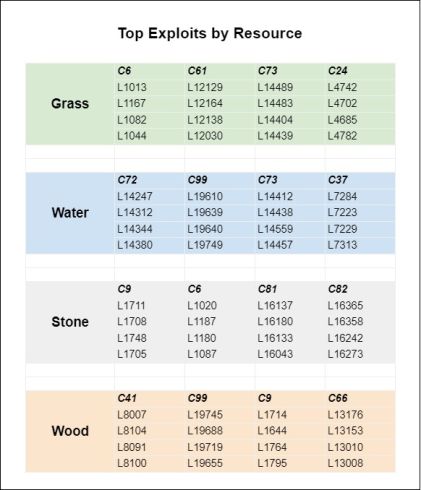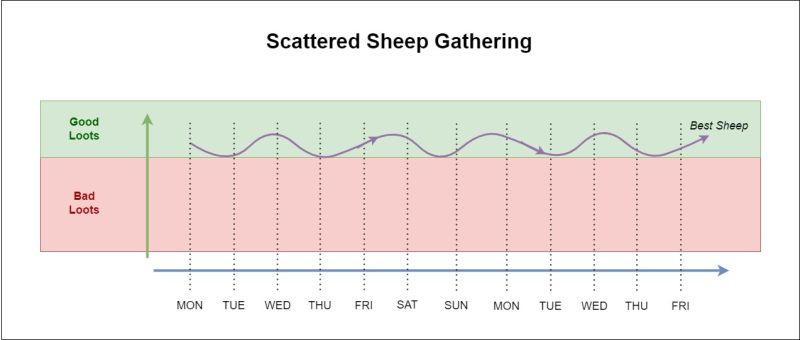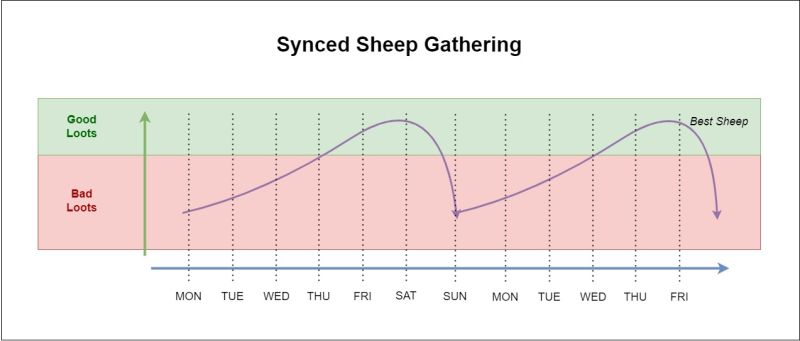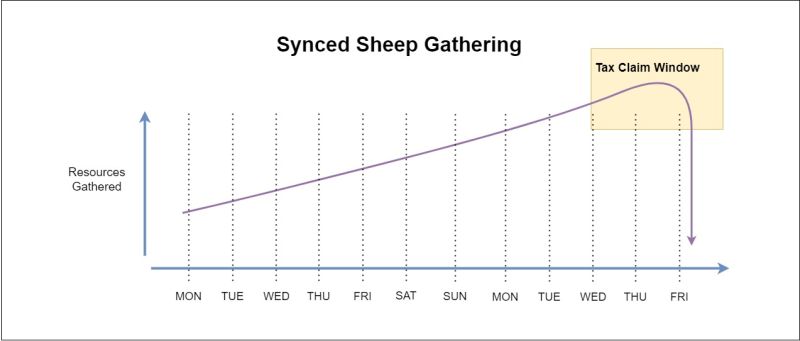A Complete Strategic Guide for Wolf Game Communities & Whales
The Foundation: Concentrate your assets in a single community.
Asset concentration unlocks new ways to play the game, and lets you exploit certain advantages to the max. This guide will dive into some of these scenarios, but for the sake of protecting my own strategy, I’ll be leaving out some details and let you connect the dots.
10,000 Foot View
“Some will play checkers. Others will play chess.” - The Shepherd
In Wolfgame, playing chess means using your pieces to work together strategically. This can include sheep, land, farmers, and wolves. In chess, a bishop is only as valuable as its placement on the board in relation to the other pieces around it. A Bishop working in concert with a Queen can be effective. However, a Bishop working in concert with a Queen, and Knight, and a Rook can be deadly. Each piece adds value to the other.
A single game piece like a Farmer may have a perceived “fixed” value, but EV for farmers changes based on your strategy and overall bag makeup. Likewise, 10 sheep gathering in a single community is more powerful than 10 sheep gathering in separate communities. When your assets work together, they produce more value.
Strength in Numbers
Animals move together in herds for a reason. It works. Gathering with your sheep in Wolf Game is no different. If you’re a good shepherd, you wouldn’t spread your flock across hundreds of acres, tending to them one at a time. This is both dangerous for the sheep and a horrible waste of time. So what might this look like for gathering strategies? Let’s think like a wolf first.
If you own a wolf, you’re looking for a nice fat sheep to loot each day. A community where all the sheep are on different gathering schedules is your best scenario. There’s almost always a good option for looting. Also, nearly every community in the game is filled with sheep that use this scattered gathering method.
So what does a wolf not want to see? Synced gathering. The synced method creates smaller windows of time where your sheep are ripe for looting. This also allows you to get deeper into the collection process if you need/want to. If a sheep gets off to a great start on finding shiny boxes, then you can claim him early and wait for the next collection cycle to start. There are also other benefits from the synced method that we’ll dive into in a bit.
A single whale can have instant success with this method, but also communities that learn to work together can experience the benefits of this model.
Resource Tax Ownership
Now let’s talk about Land. There are multiple paths to success with Land ownership. You can find the bigger Water plots in heavier water producing communities, or you can try to acquire the bigger water plots in communities that produce lower water overall.
Here’s a great example:
Jim is looking to buy a water plot and there are 3 lands available that interest him. Let’s assume each community has a 20% tax rate:
| Option | Plot # | Water Amount on Plot | Total Community Water | Resource Tax Ownership | Community Daily Production | Daily Land Production |
|---|---|---|---|---|---|---|
| A | #1616 (C9) | 176 | 29,884 | 0.5% | 1,357 | 1.57 water |
| B | #6231 | 148 | 10,680 | 1.3% | 481 | 1.25 water |
| C | #19782 (C99) | 104 | 1,616 | 6.5% | 62 | 0.8 water |
| Terms |
|---|
| Water Amount on Plot - the amount of water shown on the land image
Total Community Daily Output - The amount of water produced each day by the entire community. Resource Tax Ownership - The % of the total tax income that your plot earns in comparison to other water plots within the same community. Community Daily Production - The amount of water your community produces each day. Daily Land Production - The amount of water your land produces each day, based on your Tax Ownership and the Community Daily Production. |
So which is the best option? Here’s an overview of Jim’s choices:
Option A
Great option for a smaller player that has just a few sheep and farmers. This land will produce decent water, and doesn’t require other assets to unlock “full potential”. In other words, this plot has a high floor, but a lower ceiling. The strategy is simple: claim your taxes once a week.
There are a lot of plots like this in the game. I would consider this a “common” plot. You’ll find a lot of these listed on the floor.
Option B
Great option for someone with a lot of sheep, but fewer farmers. The Community Daily Production (CDP) can support a larger flock size, and the Resource Tax Ownership could still create an opportunity for Farmer boosts in the right environment.
These types of plots are more rare, however still abundant across the farm.
Option C
Great option for someone with a lot of farmers, and a few sheep. The higher Resource Tax Ownership (RTO) is critical for maximizing farmer strategy. Although this plot has a very low floor production, the ceiling is very high. We’ll cover that in a bit.
This is the rarest land. Lands that have highest Tax Ownership and highest value resources can sell for a premium, especially for certain buyers.
Find your Exploit
When Full Game launched in Dec 2022, a deal went down where Bulkis sold 3 water plots in C72 to Seedphrase for 1 crypto Punk. Bulkis knew he found the best “Option C” in the game, and he had a massive buyer in Seedphrase. This deal created a lot of controversy in the community for months on end. People called for Shep to “fix” this exploit, as Seedphrase was able to produce immense amounts of water from these few lands. After many months of unrest from community members regarding this exploit, Siphons were created as a means of countering the excessive production of resources. The community destroyed Seed’s ability to extract value from his land. I would argue this move to Siphons hurts the community as a whole, by making it harder for blockbuster deals like Bulkis/Seedphrase to come to fruition. Blockbuster deals are great marketing.
Some claimed this was an oversight by Shep, but the data suggests that this design is very intentional. The reality is this - some lands are worth far more than others, and the Valley has exploits of many shapes and sizes.

Here’s a graphic showing the top 4 exploits in the game for each resource, which lands you need in order to have the highest Tax Ownership. To maximize this strategy, you will want to find communities that have the lowest resource output. It works this way because communities with a lower resource will have fewer lands that produce that resource. This can give you a massive advantage of Tax Ownership.
That’s right, what Seedphrase found in C72, can be done in C99 to a lesser degree. However, with more farmers and the right lands, you could produce the same output as C72. The Wood exploit in C41 is similar in size to the Water exploit of C72, but because of the low value of wood today, this exploit isn’t valuable. In the future, if Wood becomes significantly more valuable, C41 could become the largest exploit in the game. The same goes for Grass in C6 as well.
Here are the 5 steps to running your own exploit:
- Gather with Sheep.
- Raise Taxes.
- Instant claim with Farmers.
- Claim your resources.
- Multiply your land tax with Farmers.
Gather with Sheep (critical for Option B mentioned earlier)
Your goal is to get as many resources as possible claimed within a 1 week window of each other. The best way to do that with sheep is by over diluting. Over diluting your sheep means stacking them all into one resource. This technique will mean that your sheep gather at a lower daily rate, giving them a better chance at gathering for greater lengths of time.
Depending on your flock size, you can accumulate more resources that can be claimed all at once, inside your 1 week claim window. Think of it like this, diluted gathering lets you build up a lot more resources that can be claimed all at once, which gives you an even better multiplier in step 5.
Raise Taxes
Raising taxes on your own sheep can be advantageous in the right setup. Owning more lands in your community will give you better control over the community tax %. Those tax claims can then be multiplied 10x by a big daddy/momma once you’re ready at step 5. This strategy DOES NOT always make sense, it depends on the makeup of your bag, and your farmer usage.
Instant Claim w/ Farmers (critical for Option C mentioned earlier)
Farmers Instant Claim plays a critical role in maximizing Land. Taking the Seedphrase example from earlier, the resources he can produce in C72 is directly tied to his farmers. Likewise, in the scenarios mentioned in the Top 4 Exploits by Resource graphic, the number of farmers you have will determine the ceiling for your exploit.
Just before you’re about to collect, add the instant claim on as many sheep as possible. It’s best to have all your farmers synced up on the same cooldown cycle for this method to be maximized.
Claim Your Resources
Claim as many resources as you can within a 7 day window. Remember, syncing your sheep and your farmers to work in unison will maximize the advantages in the final step.
Multiply Your Land Tax w/ Farmers
Big daddies and mommas provide the biggest reward on this step, as they provide a 10x multiplier on your land taxes. You will need 1 farmer for every 1 land tax that you want to multiply (You can’t use 1 farmer to multiply all your lands).
Improving Your Gameplay
You don't have to find an exploit to improve your own gameplay. If it were that easy, everyone would be doing it. But there are moments in this game the present unique opportunities. Here are some basic principles you can activate for your own game, and you may be surprised what you discover:
Challange Assumptions
As you play Wolf Game, you start to build habits which can then turn into assumptions. For example, you may think "I should collect this resource because it's the right thing to do." Ask yourself what assumption you are making. Then ask yourself what would happen if you went against that assumption.
Play "if, then"
This is a creative exercise that can help you start thinking outside the box. In my Synced Gathering section above, it may sound like this: "If I sync up all my sheep on the same schedule, then wolves may find it more frustrating to consistently get good loots, and I'll have certain weeks where my land taxes are higher."
Find Your Ally
Whales can easily manipulate their own assets, this gives them an edge in the game. However, a lot of whales lose some efficiency as their bag scales. Minnows of Wolf Game can get an edge when they work together. They can get the benefits of moving in sync like a whale, but they don't have the downside of lost efficiency. You can still be very precise with who/when you loot, gather, breed, etc. Working as a team and thinking creatively can unlock unique benefits.
Establish KPIs
Key Performance Indicators (KPIs) are points of data that help you understand how your operation is running. KPIs should help you measure a goal, so if you don't have a goal it will be hard to identify the best KPIs. My goal is always to earn as much wool as possible while maximizing profits. Here are a few KPIs that I track regularly:
| KPI | Notes | My Target |
|---|---|---|
| Shiny Boxes / Day | Count your boxes when you claim them. I track my rolling 10 day average. | 50 |
| Energy Spent / Day | I estimate this one. If I'm consistently getting to day 5 of gathering, then I know my energy per day is 4.4 | 3.8 |
| Wool earned / 1 energy spent | This helps me identify how "affordable" jugs are for me. I take the total amount of wool I'm earning, divided by the energy it took to earn it. | 30 |
| Wool per Month | This is my total revenue goal for my entire portfolio. | 350,000 |
| Profit Margin | I also track all wool expenses, so I can hit my profit targets. | 80% |
Track your Data
I use my own template for tracking my income and expenses. You can download the template here.
For a video tutorial on how to use the Wool Tracker, click here.



